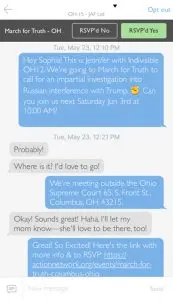By early February, two weeks after Trump’s inauguration, activists had created nearly 4,000 local chapters of Indivisible, an organization designed to pressure members of Congress. That same month, two Bay Area activists began interviewing the leaders of more than a dozen Indivisible groups and other similar new activist organizations, and found a key challenge: many were already starting to feel burned out as they juggled responding to Trump administration policies and their everyday lives.
Rapid Resist, a new platform, was created in reaction to that challenge, and based on two other findings. Most leaders were struggling to communicate with members as they dealt with multiple issues, events, and platforms. And when asked about their greatest successes, most groups pointed to actions that brought out large crowds and received media coverage.

In a pilot in March in Nevada, where Dean Heller, a Republican senator, is up for re-election in 2018, local organizers learned about a fundraiser he planned to hold 72 hours in advance and then used the platform to quickly text 2,000 people: 69 of those showed up for a demonstration against Heller’s support for the Republican health care bill.
The next day, Heller reversed his position. “He responded to that pressure,” says Yoni Landau, a former White House staffer, who co-founded Rapid Resist with Jennifer Friedmann, who led organizing for Hillary Clinton in Ohio. “His donors saw the people that turned out, he saw that there was organized mass and locally-based resistance, and flipped his stance against Trump’s agenda.” (While the protest alone was likely not the only cause, the timing of the announcement a day later suggests to Rapid Resist that it played a role in changing his mind.)

Since the first pilot, the group has texted nearly 350,000 people across the country, using 357 volunteers to do the texting. They partner with local groups in districts in which Clinton won but are represented by Republicans, or where lawmakers criticized Trump in the past or may otherwise be possible to flip on specific issues. An app called Hustle, designed for peer-to-peer mass texting, is the heart of the platform and has been tailored to make it easy for volunteers to quickly text customizable scripts to hundreds of people.
In some cases, local groups have lists of people to contact. In Simi Valley in Southern California, for example, when a Republican congressman announced a town hall meeting with short notice, the local Indivisible chapter had a list of registered Democrats. Using the platform, volunteers were able to contact 10,000 people from the list in a few hours. In other cases, Rapid Resist has lists that it can share with partners. Both organizations collaborate on the scripts. The local organizers find the events to focus on, but instead of their past methods of contacting people–often a scattered combination of Slack, Facebook, Twitter, and email, without necessarily reaching people in time–the volunteer texters handle the heavy lifting, and can often reach many more people more effectively.
“Text is intimate,” says Landau. “It lets people know something is really happening if someone has taken the effort to text them individually and have a conversation with them.”
The system is also fast. “The idea is that we’re rapid response,” says Friedmann. “We are the immune system of the resistance, in a way, because we hear about these events and we can immediately turn out mass numbers of people from that area who are local…it’s a really low effort way for leadership in those grassroots organizing groups to keep up their resistance efforts without putting a ton more work on their plate.”
Technology, the founders say, is an important part of the movement, but it needs to be tied to local action. “I think the challenge for the progressive movement right now is drilling down to find the people really doing the work on the ground,” says Landau. “Once they say ‘This is what is important in my district,’ then you can use technology to completely lift them up, recruit hundreds of people to their event, and make their lives so much easier.”
Recognize your brand’s excellence by applying to this year’s Brands That Matter Awards before the early-rate deadline, May 3.
